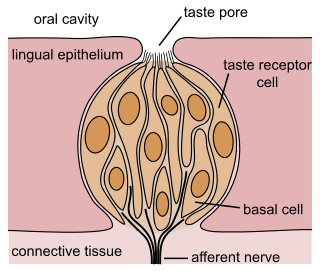
Brassica is a genus of plants in the cabbage and mustard family (Brassicaceae). The members of the genus are informally known as cruciferous vegetables, cabbages, or mustard plants. Crops from this genus are sometimes called cole crops—derived from the Latin caulis, denoting the stem or stalk of a plant.
Phenylthiocarbamide (PTC), also known as phenylthiourea (PTU), is an organosulfur thiourea containing a phenyl ring.

A food taster is a person who ingests food that was prepared for someone else, to confirm it is safe to eat. One who tests drinks in this way is known as a cupbearer. The person to whom the food is to be served is usually an important person, such as a monarch or somebody under threat of assassination or harm.

Brassica oleracea is a plant species that includes many common cultivars, such as cabbage, broccoli, cauliflower, kale, Brussels sprouts, collard greens, Savoy cabbage, kohlrabi, and gai lan.
A supertaster is a person whose sense of taste is of far greater intensity than the average person.

Propylthiouracil (PTU) is a medication used to treat hyperthyroidism. This includes hyperthyroidism due to Graves' disease and toxic multinodular goiter. In a thyrotoxic crisis it is generally more effective than methimazole. Otherwise it is typically only used when methimazole, surgery, and radioactive iodine is not possible. It is taken by mouth.
Aftertaste is the taste intensity of a food or beverage that is perceived immediately after that food or beverage is removed from the mouth. The aftertastes of different foods and beverages can vary by intensity and over time, but the unifying feature of aftertaste is that it is perceived after a food or beverage is either swallowed or spat out. The neurobiological mechanisms of taste signal transduction from the taste receptors in the mouth to the brain have not yet been fully understood. However, the primary taste processing area located in the insula has been observed to be involved in aftertaste perception.
Blinded wine tasting is wine tasting undertaken in circumstances in which the tasters are kept unaware of the wines' identities. The blind approach is routine for wine professionals who wish to ensure impartiality in the judgment of the quality of wine during wine competitions or in the evaluation of a sommelier for professional certification. More recently wine scientists have used blinded tastings to explore the objective parameters of the human olfactory system as they apply to the ability of wine drinkers to identify and characterize the extraordinary variety of compounds that contribute to a wine’s aroma. Similarly, economists testing hypotheses relating to the wine market have used the technique in their research. Some blinded trials among wine consumers have indicated that people can find nothing in a wine's aroma or taste to distinguish between ordinary and pricey brands. Academic research on blinded wine tastings have also cast doubt on the ability of professional tasters to judge wines consistently.

Cruciferous vegetables are vegetables of the family Brassicaceae with many genera, species, and cultivars being raised for food production such as cauliflower, cabbage, kale, garden cress, bok choy, broccoli, Brussels sprouts, mustard plant and similar green leaf vegetables. The family takes its alternative name from the shape of their flowers, whose four petals resemble a cross.
The Kell antigen system is a human blood group system, that is, a group of antigens on the human red blood cell surface which are important determinants of blood type and are targets for autoimmune or alloimmune diseases which destroy red blood cells. The Kell antigens are K, k, Kpa, Kpb, Jsa and Jsb. The Kell antigens are peptides found within the Kell protein, a 93-kilodalton transmembrane zinc-dependent endopeptidase which is responsible for cleaving endothelin-3.
Coffee cupping, or coffee tasting, is the practice of observing the tastes and aromas of brewed coffee. It is a professional practice but can be done informally by anyone or by professionals known as "Q Graders". A standard coffee cupping procedure involves deeply sniffing the coffee, then slurping the coffee from a spoon so it is aerated and spread across the tongue. The coffee taster attempts to measure aspects of the coffee's taste, specifically the body, sweetness, acidity, flavour, and aftertaste. Since coffee beans embody telltale flavours from the region where they were grown, cuppers may attempt to identify the coffee's origin.

Tea tasting is the process in which a trained taster determines the quality of a particular tea. Due to climatic conditions, topography, manufacturing process, and different cultivars of the Camellia sinensis plant (tea), the final product may have vastly differing flavours and appearance. A trained tester can detect these differences and ascertain the tea's quality prior to sale or possible blending.

A taste receptor or tastant is a type of cellular receptor which facilitates the sensation of taste. When food or other substances enter the mouth, molecules interact with saliva and are bound to taste receptors in the oral cavity and other locations. Molecules which give a sensation of taste are considered "sapid".

Taste receptor 2 member 38 is a protein that in humans is encoded by the TAS2R38 gene. TAS2R38 is a bitter taste receptor; varying genotypes of TAS2R38 influence the ability to taste both 6-n-propylthiouracil (PROP) and phenylthiocarbamide (PTC). Though it has often been proposed that varying taste receptor genotypes could influence tasting ability, TAS2R38 is one of the few taste receptors shown to have this function.

Wine tasting is the sensory examination and evaluation of wine. While the practice of wine tasting is as ancient as its production, a more formalized methodology has slowly become established from the 14th century onward. Modern, professional wine tasters use a constantly evolving specialized terminology which is used to describe the range of perceived flavors, aromas and general characteristics of a wine. More informal, recreational tasting may use similar terminology, usually involving a much less analytical process for a more general, personal appreciation.

The aromas of wine are more diverse than its flavours. The human tongue is limited to the primary tastes perceived by taste receptors on the tongue – sourness, bitterness, saltiness, sweetness and savouriness. The wide array of fruit, earthy, leathery, floral, herbal, mineral, and woodsy flavour present in wine are derived from aroma notes sensed by the olfactory bulb. In wine tasting, wine is sometimes smelled before taking a sip in order to identify some components of the wine that may be present. Different terms are used to describe what is being smelled. The most basic term is aroma which generally refers to a "pleasant" smell as opposed to odour which refers to an unpleasant smell or possible wine fault. The term aroma may be further distinguished from bouquet which generally refers to the smells that arise from the chemical reactions of fermentation and aging of the wine.

The gustatory system or sense of taste is the sensory system that is partially responsible for the perception of taste (flavor). Taste is the perception produced or stimulated when a substance in the mouth reacts chemically with taste receptor cells located on taste buds in the oral cavity, mostly on the tongue. Taste, along with olfaction and trigeminal nerve stimulation, determines flavors of food and other substances. Humans have taste receptors on taste buds and other areas, including the upper surface of the tongue and the epiglottis. The gustatory cortex is responsible for the perception of taste.
Laurence Hasbrouck Snyder was a pioneer in human genetics and president of the University of Hawaii.
The evolution of bitter taste receptors has been one of the most dynamic evolutionary adaptations to arise in multiple species. This phenomenon has been widely studied in the field of evolutionary biology because of its role in the identification of toxins often found on the leaves of inedible plants. A palate more sensitive to these bitter tastes would, theoretically, have an advantage over members of the population less sensitive to these poisonous substances because they would be much less likely to ingest toxic plants. Bitter-taste genes have been found in a variety of species, and the same genes have been well characterized in several common laboratory animals such as primates and mice, as well as in humans. The primary gene responsible for encoding this ability in humans is the TAS2R gene family which contains 25 functional loci as well as 11 pseudogenes. The development of this gene has been well characterized, with proof that the ability evolved before the human migration out of Africa. The gene continues to evolve in the present day.

PTC tasting is a classic genetic marker in human population genetics investigations.











